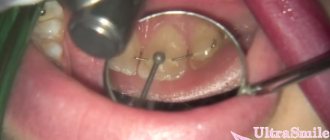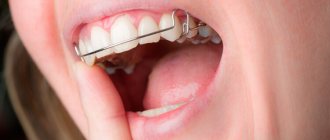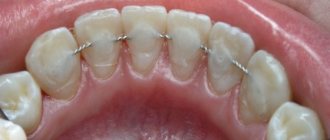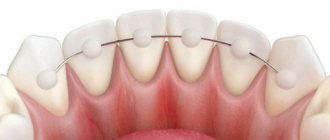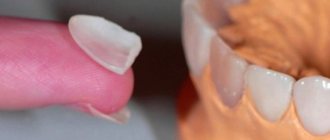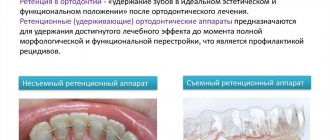Orthodontic treatment does not end when braces are removed. To maintain the results obtained by keeping the teeth in the correct position, patients have to wear a so-called retainer for some time. Today, there are various options for retention structures of removable and non-removable types, but due to the successful combination of functionality and cost, the most popular is the non-removable wire type. It is miniature in size and is attached to the lingual side of the teeth, remaining invisible to others. The type of retainer is chosen by the attending physician, depending on the clinical situation and the pathology of the bite.
Types of devices: which ones break down and come off more often
Several types of retention devices are used in orthodontic practice. Conventionally, they can be divided into removable [1] and those that cannot be removed from the mouth independently.
Removable devices
Removable types are represented by special aligners (not to be confused with aligners that straighten the dentition!). The cost of such mouthguards is low, about 3000-5000 rubles. They complete treatment in situations where it is impossible to install a permanent retainer. In some clinical cases (we will definitely consider them further), they can also act as an additional measure, and then they are used in conjunction with non-removable systems.
On a note! Rarely, removable devices such as trainers, plates and face bows are used as an auxiliary measure during the retention period. Typically, the need for their use arises when there are bite pathologies that need correction. For example, trainers are used for functional disorders and in order to form correct muscle memory.
The mouthguards are very aesthetic and easy to use. They are easy to clean and can be removed from the mouth when eating and brushing teeth. But not everyone likes the fact that the time the devices are in the mouth constantly has to be monitored. You must not forget to install mouth guards, for example, at night, and this requires a high level of self-control from patients, otherwise the entire result can quickly fade away.
You need to understand that such products simply cannot come off, since no one glues them to the teeth. The risk of their breakage is also low.
Fixed structures
In most cases, treatment results are consolidated using the second group of devices, which are non-removable. These are the ones that are fixed to the teeth using special glue and filling material.
The structures consist of stainless metal wire or other rigid material (fiberglass and nylon thread). They are fixed in pre-created grooves or recesses on the inner (lingual) side of the row. Or they are simply glued to the inner surface of the teeth (today this option is used more often).
Non-removable retainers are lightweight, compact, aesthetic, do not cause discomfort and do not interfere with the beauty of your smile, and are designed for a long period of use. That is why they are installed on a large number of patients. True, you have to get used to it, because... in the first few days the structure will interfere with the tongue.
Important! A non-removable retainer accompanies the patient while eating, brushing teeth, talking, sleeping; hygienic care of the oral cavity is difficult in it, so situations often occur when it comes off, falls off or bends.
Removable raters
Probably, the plastic mouth guard has the most aesthetic appearance among all removable retainers. The product is completely transparent and invisible to others during a conversation. Unfortunately, a mouth guard, like all removable retainers, can affect diction and must be removed while eating.
If the orthodontist allows the patient to wear a mouth guard only at night, then wearing it for a very long time will not cause any discomfort and may remain a secret even to those closest to you.
Features of installing fixed systems
As a rule, fixed appliances are installed in the area of the front teeth. They capture the six anterior elements of the row (all incisors and canines), less often - only four incisors, but in this case they are complemented by a removable mouth guard, which we discussed above. This measure prevents the teeth from returning to their original position.
Fixed appliances are very rarely installed on molars and premolars due to the anatomical features of these teeth and the complexity of fixation. The only exceptions are those cases when the first and second premolars are removed during orthodontic treatment - then the structures are fixed in order to avoid the formation of cracks and spaces between units of the row.
How are permanent retainers installed?
Immediately before installing the systems, the specialist refers the patient to professional teeth cleaning, where all types of plaque are removed. Then an x-ray is taken to determine the position of the roots. And the installation process itself looks like this:
- the doctor creates small depressions or grooves on the inside of the dentition (if necessary),
- polishes the lingual surface (from the side of the tongue) and applies an etching gel to it,
- the tissues are thoroughly dried, treated with an adhesive composition, after which the retention wire is positioned,
- the wire is covered with a composite material on top,
- The composite is polymerized with a lamp, carefully ground and polished.
Reasons leading to non-removable appliances peeling off
Let's look at the main reasons why the retainer comes off.
Medical errors
Doctors themselves are often involved in the fact that the retainer comes off because they did not properly treat hard tissues before the procedure and after gluing the device. Placement of a fixed system is a very delicate job that requires accuracy and precision from the orthodontist[2].
If you make a mistake at one of the stages (poorly polish, dry and clean hard tissues, do not completely remove saliva and tissue fluid, install the system in the wrong place, apply filling material poorly), then a situation where the retainer, its edge or tip has completely peeled off - it's only a matter of time.
Important! If the structure is initially installed incorrectly, then it will bear a serious load, which will lead to the retainer breaking or bending.
The doctor’s mistake may consist not only in the violation of the technique of preparing the dentition for the installation of devices and in the incorrect positioning of the structures, but also in the fact that the specialist began the retention period ahead of time, that is, at the stage when occlusion pathologies are not completely eliminated.
Negligent attitude of the patient to the recommendations of the orthodontist
Situations where the tip of the retainer or its edge have come off often arise because the patient does not follow the prescribed diet or eats too hard and sticky foods.
Excessive zeal during oral hygiene, inaccurate and too aggressive use of brushes, dental floss, brushes, toothpicks, or lack of proper dental care are factors that lead to your retainers constantly coming off.
Important! According to statistics, devices located on the upper jaw most often come off and break. This occurs due to the inability to place the wire in a place where it would not come into contact with the antagonist teeth located on the lower jaw.
Caries and other dental diseases
If the retainer has come off and the tooth underneath it hurts, this may indicate the development of caries, pulpitis, or periodontitis. In this case, a carious cavity forms on hard tissues, the surface topography changes, and, accordingly, the quality of adhesion of the enamel to the structure and filling materials drops sharply. The problem can arise either due to the fault of the doctor who violated the rules of asepsis when installing the structures, or due to the fault of the patient who did not provide thorough hygienic care to the oral cavity while wearing retainers.
Important! It must be said that non-removable retainers are usually worn for a fairly long period (from 3-5 to 10-15 years). Poor oral hygiene can lead to bacterial plaque accumulating under and around structures, causing not only caries and its complications, but also inflammation of periodontal tissue (gingivitis, periodontitis).
It is important to emphasize that in those places where fillings are installed on the teeth, non-removable appliances, in principle, are fixed less well, so it is possible that they will periodically come off.
The cause of the failure is a relapse of orthodontic treatment.
If, during treatment with braces, the doctor was unable to completely eliminate the cause that caused the anomaly in the dental system, it will sooner or later become more active and cause malocclusion. The process will start again, only this time the chewing load will increase not only on some teeth, but also on the retention apparatus that stabilizes them in the correct position. In this case, it is impossible to avoid peeling off or breaking the wire tire, no matter what its diameter.
In this case, it is necessary to conduct a thorough analysis of the correction performed, identify any mistakes made, and, unfortunately, repeat the orthodontic treatment.
| Retention devices The wonderful moment of the appearance of a gorgeous smile after wearing braces must be secured. For this purpose, professionals use a special device - a retention device, or retainer. It is needed so that the results from bite correction stay with you for life. Smile Studio specialists take care to achieve the maximum effect from their work and always include the retention stage in the course of treatment. | 6 000 ₽ |
How can you tell if your retainer has come off?
This is not difficult to do. The design may begin to cause discomfort, scratch the oral mucosa, and leave wounds on the tongue or palate. Patients who suffer from pathology often notice a strange crunching sound while eating food.
If you do not solve the problem, you will notice that in the place where the retainer broke, the tooth “moved away”, that is, it shifted to its original position, which it occupied at the previous stages of treatment. Doctors say that this phenomenon is more typical for the lower jaw, the incisors and canines of which can change their positions in just a few days. You can see in the photo what the oral cavity looks like when the retainer has come off and the teeth have begun to move back apart.
“I didn’t immediately notice that my retainer had come off. The wire is so thin that I didn’t even feel any discomfort. And I found out about the problem in a very interesting way: during one of my morning brushings I saw in the mirror that a gap had appeared between my teeth, which, oh my God, took me a year and a half to get rid of!!! True, the diastema was smaller than before, but still! This is very disappointing! Be more attentive to yourself and don’t think that because you wear retainers, you don’t need to control this process the same way as with braces. It’s necessary, and how!”
Tinka, review from gidpozubam.ru
How long should retainers be worn after braces are removed?
Do I need to wear retainers for life? In fact, all situations are individual and depend largely on the recommendations of the attending physician. What can influence the duration of the retention period?
- Complexity of the orthodontic case
- Patient age
- The level of hygiene and the presence of bad habits in the patient
- Periodontal status (gum condition)
- The presence of orthopedic structures in the mouth - veneers, crowns
As a rule, orthodontists recommend wearing a retainer for at least the duration of orthodontic treatment, that is, from 1.5 to 2 years. Be prepared that the doctor also takes into account the patient’s organization. If you have often missed visits to monitor your treatment, then retainers may be indicated for you for a longer period, as a guarantee of the safety of the result.
What absolutely should not be done if a problem arises
- remain inactive for a long time: if the retainer comes off, how long can you walk like this? Doctors say that the maximum that is possible here is 2-4 days. If you ignore the problem for longer, the teeth will gradually begin to take the incorrect position that they occupied before the bite correction,
- glue the device yourself, especially using non-medical adhesives: you can cause damage to surrounding tissues, provoke an inflammatory process,
- tear off or cut off the loose piece,
- remove the device at home: you can damage your teeth, gums, and mucous membranes.
The best solution is a visit to the clinic
If the edge of the retainer has come unstuck, or the structure has completely moved away from the teeth, is bent and damaged, then you need to see your orthodontist as soon as possible. The specialist, depending on the situation, will re-glue the required fragment, or completely remove the device (if damaged or broken) and replace it with a new one.
How do you remove a retainer if it is broken or bent? Using a bur, the doctor carefully files away the glue and composite material, after which he removes the structure and prepares the surface of the teeth for installation of a new system (polishes, etches, dries).
If it turns out that the retainer has come off on one tooth or along an entire row, and this was due to bite pathologies that were not completely eliminated, then it is important to return to the pre-retention period, that is, again install stronger and more effective orthodontic appliances, for example, braces.
If caries is found under the structure, the orthodontist removes the device and transfers the patient to the hands of a dentist-therapist. After therapeutic manipulations, you can return to the orthodontist’s chair in order to fix the new structure.
Tags
how the teeth accepted braces dental arch and teeth will accept the surfaces of the teeth on the sides of the teeth micro-movements of the teeth. systems dental surface surfaces of the teeth. tooth breakage or in the dentition. Correction of the bite from restoration of the bite follows restoration of the bite with braces Correction of the bite in braces course of braces begins removal of braces dental removal of braces usually bite with braces closure treatment with braces. treatment with braces . Braces to braces treatment process treatment process. treatment process. treatment results during treatment all during treatment with braces. results of treatment with braces. your treatment and treatment process treatment process
prostheticsalignerspricesrecordprosthesiscariesquestionservicesarticlebackreviewsremovalimplantationchildrenyourpromotionschildrencontactsverycrownsrestorationdiagnosticsgivedamonwhiteningimplantstelephonedataceramicpersonalsentandimplantsfree surgeryanalysischildrenasked
